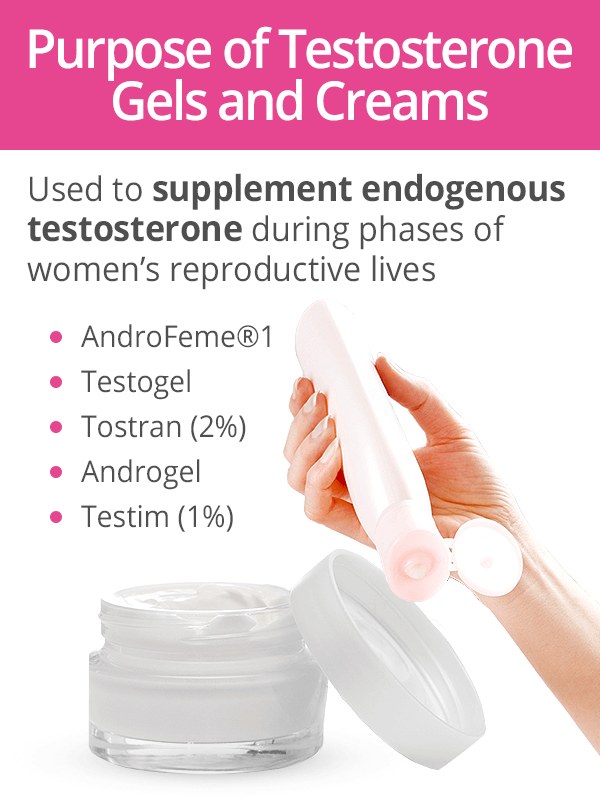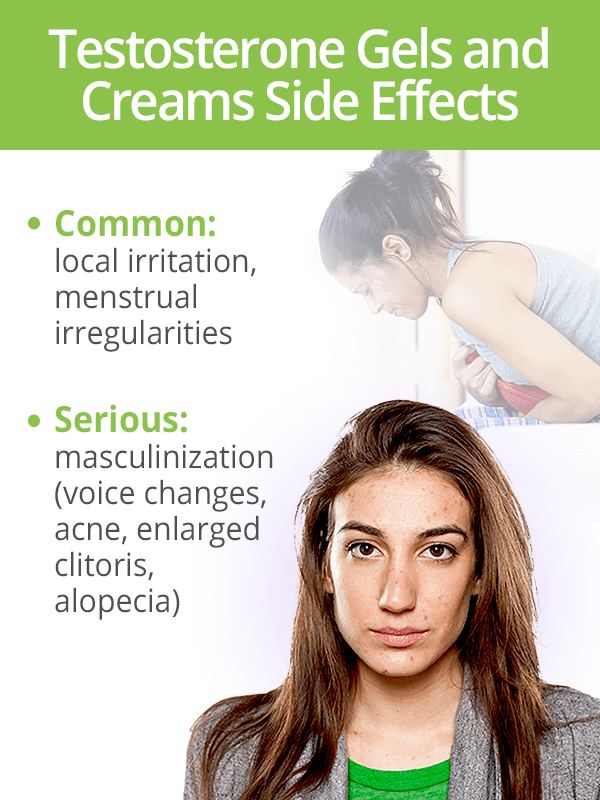On the path to hormonal balance, learn all there is to know about testosterone gels and creams, including how, when, and why they are used in comparison to other methods.
What are Testosterone Gels & Creams?

Testosterone gels and creams are liquid applications used to supplement the amount of testosterone that the woman's body should be creating.
When Could Their Use Prove Beneficial?
During premenopause, testosterone cream for women has been proven to improve well-being, mood, and sexual function in women with low libido caused by oral contraceptives. After menopause, topical testosterone is also prescribed for the same reasons. Its use pre- and postmenopause still proves controversial.
Common Testosterone Gels & Creams for Women
Common testosterone gels and creams used in women include AndroFeme®1, Testogel, Tostran (2%), Androgel, and Testim (1%). The latter two are approved for use in the U.S. for men and compounded for women at a weaker dosage.
Benefits of Testosterone Gels & Creams

Mainly, testosterone gels, creams, and even ointments are used for treatment of sexual desire disorder in addition to being used alongside oral contraceptives, which decrease levels of free testosterone in women.
Symptoms of androgen deficiency include the following, which can be relieved with the supplementation of testosterone gels and creams:
- Lack of motivation
- Loss of libido
- Lethargy
- Depressed moods
- Loss of muscle mass and strength
- Lack of arousal
- Insomnia
- Headaches
- Vasomotor symptoms
- Anxiety
- Lowered sexual enjoyment
- Reduction in fantasies
- And many more
How and When to Use Them

How Do I Apply Topical Testosterone?
Testosterone gels and creams are applied directly to any clean, dry surface of the skin. The most common application sites are the thigh, arm, abdomen, clitoris, or labia.
Also, keep the following tips for safe use in mind. Do not allow the testosterone to come in contact with anyone else, and wash hands immediately after application. Furthermore, do not wash the area where it was administered until at least three hours later.
When Do I Use Topical Testosterone?
No matter the age, when using to improve sexual desire, an appropriate dosage of compounded 1 percent testosterone gel, cream, or ointment is 0.5 grams daily. This delivers 5 mg of testosterone per day, which is one tenth of the generally prescribed dosage for men.
In general, topical testosterone is considered off-label use for women as it is hard to regulate the amount of testosterone delivered. Recommendations are to monitor blood levels after the first three weeks and then every six months.
Testosterone Gels & Creams Side Effects

Under the direction of a doctor during treatment, applying small dosages for short-term use of topical testosterone should not cause adverse effects as long as it is balanced accordingly with estrogen and progesterone.
However, a more common side effect that some women complain of concerns genital application. Genital application, even though it increased sensitivity in tissues, can lead to local irritation. Moreover, the application process can be messy and cause menstrual irregularities or spotting.
With extreme dosing, more serious side effects of testosterone gels and creams include those related to masculinization, including acne and female-patterned balding (less common) in addition to deepening of the voice and an enlarged clitoris (rare).
It is important for women to keep a note of caution in mind. When applied to the arm, abdomen, or thigh, the concentration of testosterone in the gel or cream may transfer to a partner or child.
Where Can I Buy Them?
Topical testosterone can be purchased with or without a prescription online or in a pharmacy. Since dosing should not be estimated by the woman using the medication, correct dosages should be prescribed by a certified healthcare professional.
Key Takeaways
In conclusion, testosterone gels and creams can be used to increase levels of the hormone already present in a pre- or postmenopausal woman. Doing so generally amends symptoms associated with androgen deficiency, especially those associated with sexual dysfunction. Testosterone gels and creams are generally used alongside oral contraceptives or on its own. Similar to other hormone treatments, side effects may evolve if too strong of a dosage is prescribed or if used incorrectly. All topical testosterone medications should be used under a doctor's close monitoring.
Learn more about natural testosterone supplements and boosters before taking the risk with pharmaceutical options, such as testosterone creams and gels. Hormonal imbalances can sometimes be solved by taking healthy, preliminary measures first.
Sources
- Borgelt, L.M. et al. (Eds.). (2010). Women's Health Across the Lifespan: A Pharmacotherapeutic Approach. Maryland
- Chelsea and Westminster Hospital. (2017). Testosterone replacement for female androgen deficiency syndrome. Retrieved November 5, 2018, from http://www.chelwest.nhs.uk/services/womens-health-services/gynaecology-services/menopause-and-pms-clinics/links/Testosteronereplacementforfemaleandrogendeficiency092017CWAGREED.pdf
- Jakiel, G. & Baran, A. (2005). Androgen deficiency in women. Endokrynologia Polska, 56(6), 1016-1020. Retrieved November 5, 2018, from https://www.ncbi.nlm.nih.gov/pubmed/16821229
- Jean Hailes for Women's Health. (2014). How much testosterone is too much for women after menopause? Retrieved November 5, 2018, from https://jeanhailes.org.au/news/how-much-testosterone-is-too-much-for-women-after-menopause
- NPS MedicineWise. (2018). AndroFeme 1 Cream. Retrieved November 5, 2018, from https://www.nps.org.au/medical-info/medicine-finder/androfeme-1-cream
ScienceLine. (2008). Sexing Up the Pill. Retrieved November 5, 2018, from http://scienceline.org/2008/11/health-joelving-birth-control-pill-plus-testosterone/ - Victoria State Government. (2017). Androgen deficiency in women. Retrieved November 5, 2018, from https://www.betterhealth.vic.gov.au/health/conditionsandtreatments/androgen-deficiency-in-women
- Wickman, J.M. et al. (2014). Androgen Therapy in Women. U.S. Pharmacist, 39(8), 42-46. Retrieved November 5, 2018, from https://www.uspharmacist.com/article/androgen-therapy-in-women
